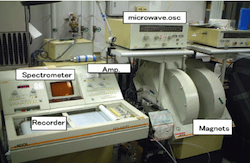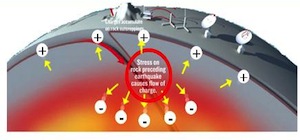
Terada Lab. Home > Research > Earth environment and evolution
Earth environment and evolution
We are developing various analytical methods such as ESR and laser breakdown spectroscopy to elucidate the formation process and transition history of planetary environments, and to monitor various planetary environments.
Electron Spin Resonance (ESR) and Optically Stimulated Luminescence (OSL)

ESR analysis targets electron spins in materials. This reflects the molecular structure of the substance, as well as radiation exposure and thermal history. By taking advantage of these properties, various physicochemical events such as irradiation processes and thermal history that occurred in outer space and the global environment can be revealed.
We are conducting development and sensitivity improvement of micro-stripline (MSL) resonators for ESR analysis of carbon substances (kerogen) and humic acid related to organic geochemistry. We are also working on the measurement of hydrated substances using it.
High intensity laser analysis and laser remote sensing
Non-linear effect of a tera-watt class femtosecond laser produces coherent supercontinuum light continuously covering ultraviolet to infrared wavelength. We have realized a multi-wavelength backscatter laser radar, and have succeeded in measuring the size distribution and shape of fine particles in the atmosphere.
We also conduct laser breakdown spectroscopy in high-pressure gas and water using high-intensity lasers, assuming the deep sea and Venus atmosphere. We are considering the development of a small-size isotope analyzer using a semiconductor laser.
Exploration for life using dielectric spectroscopy
It is known that when a high frequency of up to several tens of megahertz is applied to a bacterial suspension, the dielectric spectrum changes depending on the cell number and proliferation. We are conducting experiments with archaea, such as methane bacteria, for the application to the underground biosphere observation and life exploration on planets.
Pre-earthquake electromagnetic phenomena

Recently, electromagnetic phenomena preceding earthquakes have been observed in a wide range from the ionosphere to the atmosphere and the crust (Lithosphere-Atmosphere-Ionosphere: LAI Coupling). To generate electromagnetic phenomena, a mechanism causing electric polarization is required.
For example, the piezoelectric effect in the earth's crust, streaming potential, positive hole conduction, etc. are thought to be the causes. We conduct laboratory experiments to apply stress to rock samples and analyze seismic waves and ionospheric observation data. We are also interested in recording and analyzing a wide range of earthquake precursors.
